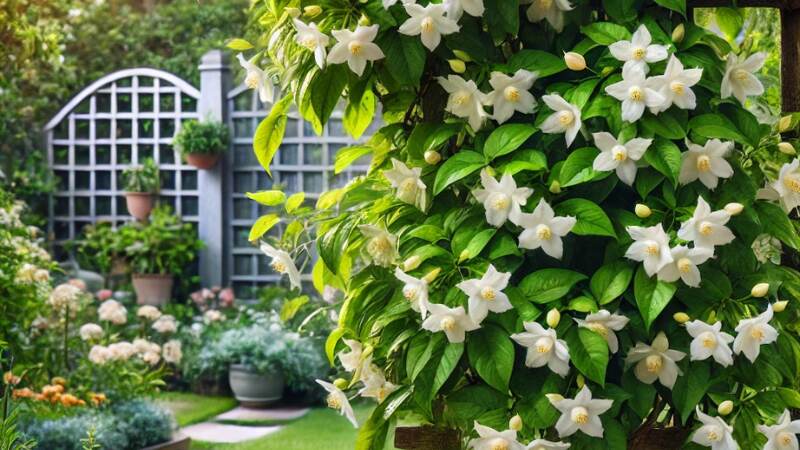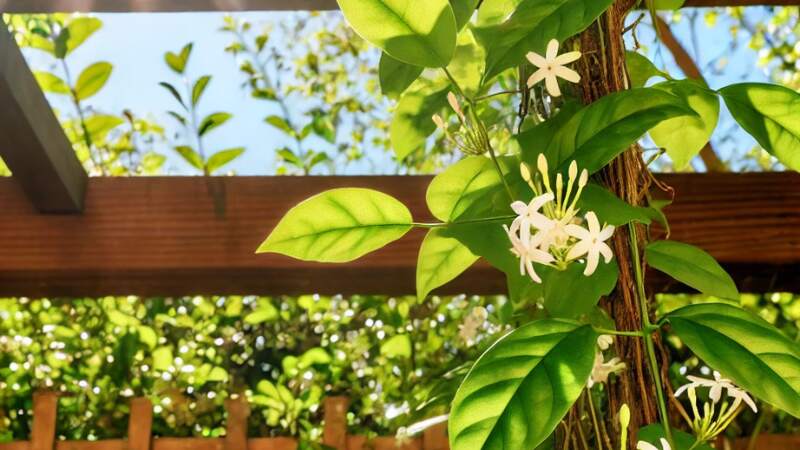Confederate Jasmine, or Trachelospermum jasminoides, is an attractive, fragrant evergreen vine that transforms gardens, patios, and indoor spaces into vibrant, green havens. It is known for its delicate white, star-shaped flowers, and sweet fragrance.
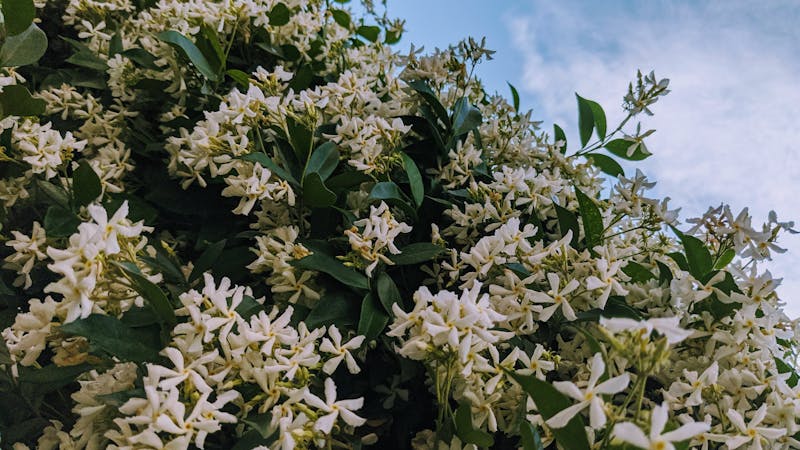
Confederate jasmine (often called star jasmine) is a favorite of beginning gardeners because of its hardiness, aesthetic appeal, and manageable care needs.
This comprehensive guide will teach beginners everything they need to know about growing Confederate jasmine. from understanding its ideal growing conditions to ongoing care tips for healthy growth.
Introducing Confederate Jasmine: Confederate jasmine is native to East Asia and prized for its lush, dark green foliage and sweet-scented flowers. Although it is not a true jasmine, its flowers have a fragrance that rivals the classic jasmine scent. and it blooms profusely in the warmer months.
As a climber, it can reach heights of 10-15 feet when trained on trellises or fences, making it ideal for adding vertical greenery and privacy to outdoor settings. Confederate jasmine is hardy and versatile, adapting well to a variety of environments when its basic needs are met. In the following sections, we’ll discuss every aspect of its care, so you can enjoy a thriving, beautiful plant.
Ideal Growing Conditions for Confederate Jasmine: To ensure Confederate Jasmine thrives, it is important to understand its preferred growing conditions. Let’s dive into its soil, sunlight, and climate needs.
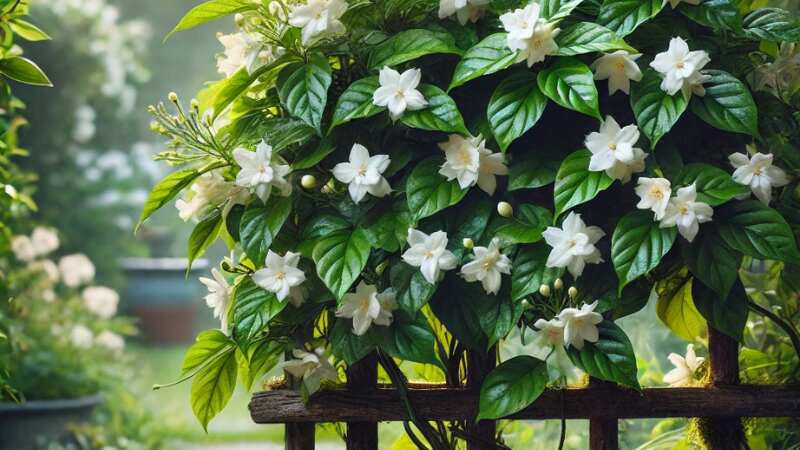
Climate requirements Confederate jasmine grows best in warm, temperate climates, especially USDA zones 8 through 10. In these areas, it can be grown outdoors year-round, as it tolerates mild winters but may struggle in areas with long frosts or severe winters.
Temperature Range: Confederate jasmine thrives in temperatures between 60-85°F. Although it can tolerate brief exposure to cold temperatures, it is best to protect it from frost if you live in an area with severe winters.
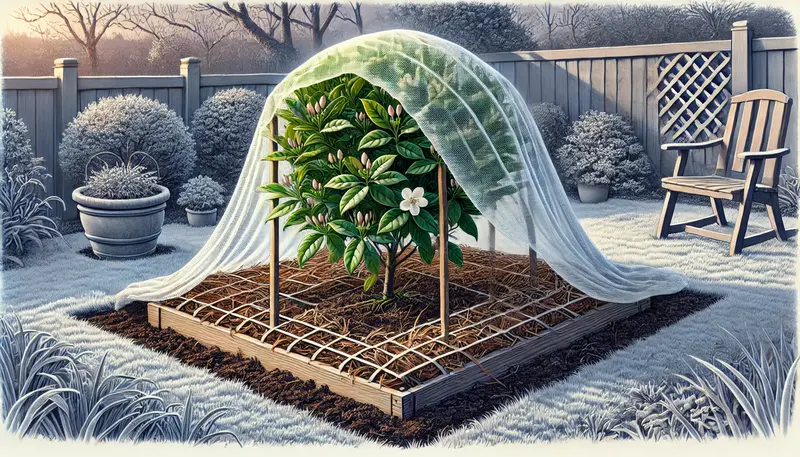
In hot areas, provide some afternoon shade to prevent leaf burn. For optimum growth, avoid placing it in areas with extreme temperature fluctuations.
If a sudden frost is expected, cover outdoor plants with fabric or temporarily move potted plants indoors.
Moisture: It prefers moderate to high moisture, although it can adapt to dry conditions if properly watered. For gardeners in colder climates, Confederate jasmine can be grown in containers and brought indoors during winter. Indoors, a bright, warm location will help it adapt and thrive.
Water deeply but infrequently to promote deep root development, especially in dry climates. A layer of mulch around the base can help retain soil moisture in outdoor gardens. Use humidity trays indoors to provide extra moisture to plants sensitive to dry air
The best soil for Confederate Jasmine: Soil plays an important role in the health of Confederate Jasmine. This plant is not light, but certain soil conditions will promote better growth and flowering. Creating the perfect soil environment will enable Confederate Jasmine to thrive in any landscape.
Confederate Jasmine requires high-quality soil to thrive and grow. While this plant is resilient, the appropriate soil conditions can greatly increase its vigor and flowering potential. Well-drained, nutrient-rich soil supports root health, while appropriate pH levels encourage optimal nutrient uptake.
Soil Type: Confederate jasmine favors well-drained, loamy soil rich in organic materials. Good drainage is important because waterlogged soil can lead to root rot, a common problem for many grape varieties. Confederate jasmine prefers well-drained, loamy soil rich in organic materials.
Loamy soil provides a balanced mix of sand, silt, and clay, promoting healthy root growth and nutrient uptake. Adequate drainage is essential to prevent root rot, a common problem in waterlogged soils. Make sure your soil texture encourages aeration and has enough nutrients to support plant growth and flowering needs.
Soil pH: The plant does well in slightly acidic to neutral soil, ideally within a pH range of 6.0 to 7.0. You can test your soil’s pH with a soil testing kit, available at most garden centers, to see if adjustments are needed. This plant favors slightly acidic soil over neutral soil, with an ideal pH of 6.0 to 7.0.
Testing the pH helps you determine if adjustments are needed for optimal growth. Acidity or alkaline imbalances can hinder nutrient uptake, affecting overall plant health. Use a simple soil testing kit, widely available at garden centers, to measure the pH of your soil and modify it as needed for optimal growing conditions.
Soil amendment: If your clay soil retains water, consider adding sand or perlite to improve drainage. Adding compost or peat moss to sandy soils will help retain the necessary moisture. For soils with heavy clay content that retain more water, add sand or perlite to improve drainage and prevent root rot.
If your soil is sandy and drains too quickly, add compost or peat moss to retain moisture. These amendments help maintain a balanced moisture level, ensuring that Confederate Jasmine has the ideal environment for root health and sustainable growth.
Each of these elements—soil type, pH, and amendments—plays an important role in supporting the health and flowering potential of Confederate jasmine. Improving these conditions will result in a stronger, more vibrant plant
Soil preparation: For outdoor planting, dig a hole twice the size of the plant’s root and mix in compost or aged manure. This will enrich the soil and improve water retention. For container-grown plants, use a high-quality potting mix designed for flowering plants and make sure the pot has good drainage.
Sunlight Requirements for Confederate Jasmine: Confederate jasmine needs a balance of sunlight and shade to thrive and bloom optimally.

Full Sun to Part Shade: Ideally, Confederate Jasmine should receive at least 4-6 hours of direct sunlight each day. Full sun exposure will encourage more blooms, while partial shade in the afternoon can protect it from extreme heat in hot weather.
Sunlight in different climates: In cooler climates, aim for more sunlight, ideally in a spot with morning sun and afternoon partial shade. In hot areas, a little more shade, especially during the afternoon hours, will prevent leaf scorch and dehydration.
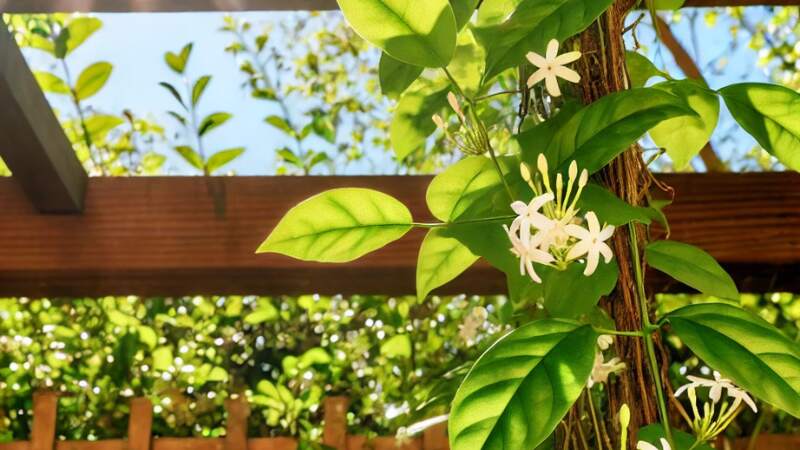
Features the same guidance for sunlight preferences in cool versus hot climates, ensuring it remains relevant to prevent dehydration and leaf damage in the hot sun.
Indoor light requirements: If you grow Confederate jasmine indoors, place it near a south- or east-facing window where it can get bright, indirect light. If your indoor space is dim, consider incorporating natural light with grow lights to maximize growth. Confederate jasmine adapts well to a range of light conditions, but flower and plant health will improve with adequate sun exposure.
How to Care for Confederate Jasmine
Once confederate jasmine is planted in its ideal conditions, ongoing care is simple but critical to maintaining its health. Below are essential care tips for watering, fertilizing, pruning, and pest control. Reinforces the need for constant care with the same key tasks (watering, fertilizing, pruning, and pest management), expanding a bit on why they are important.
Watering Confederate Jasmine
Frequency of watering: Confederate jasmine likes consistently moist soil but not too wet. During the growing season (spring through early fall), water the plant deeply once or twice a week, allowing the top inch of soil to dry out between waterings.
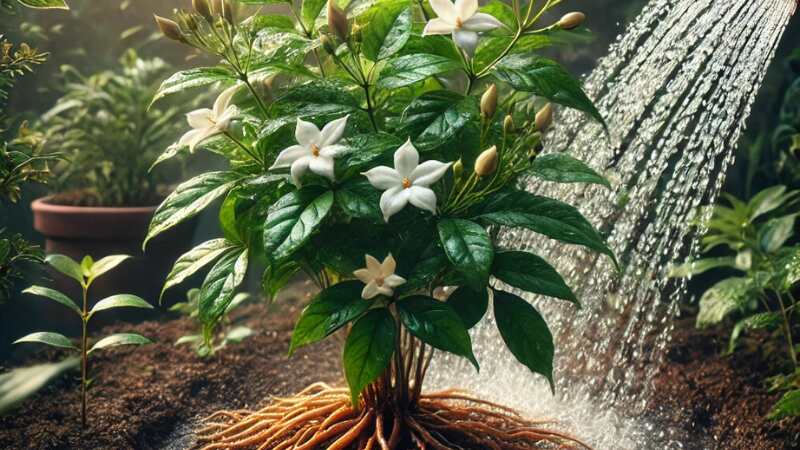
Seasonal Water Adjustment: During fall and winter, reduce the frequency of watering, as plant growth slows down. Restates the need for less water in the cooler months and emphasizes why (to prevent overwatering and support seasonal plant health.
Container plants: If growing confederate jasmine in a container, check soil moisture regularly, as containers tend to dry out faster than garden beds. Reiterates the need to check moisture frequently and why—containers dry out faster than garden beds—while maintaining the same advice with additional clarification.
Fertilizing Confederate Jasmine
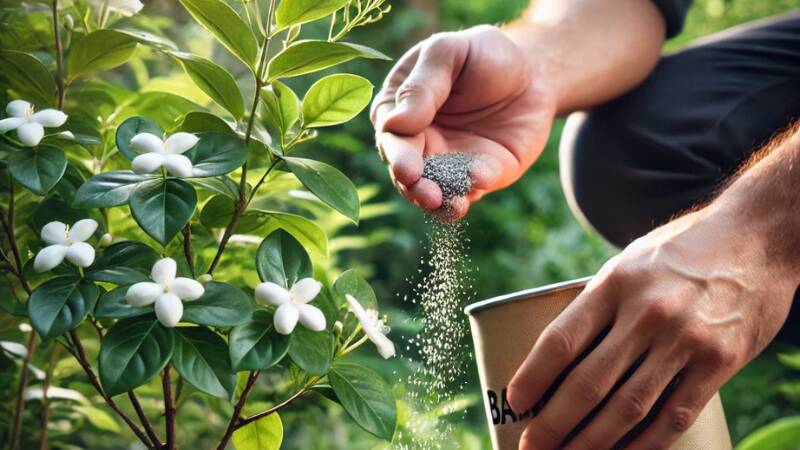
Fertilization encourages healthy plants and abundant blooms. Confederate jasmine benefits from a light, balanced fertilizer. Emphasizes the use of a balanced fertilizer and explains its role in promoting lush growth and flowering while maintaining the original recommendation.
Type of fertilizer: For Confederate jasmine, use a balanced, slow-release fertilizer with a 10-10-10 formula, providing equal parts nitrogen, phosphorus, and potassium. This ratio supports uniform growth promoting both foliage and flowers.
Slow-release formulas are ideal because they consistently deliver nutrients over time, preventing nutrient overload and promoting healthier, more controlled growth.
When to Fertilize: Fertilize in early spring to encourage new growth as the plant awakens from dormancy. A second, lighter application in mid-summer can provide an additional boost if needed. Avoid over-fertilizing, as excess nutrients can lead to overly lush foliage with fewer flowers, reducing the plant’s decorative appeal.
Pruning Confederate Jasmine
Pruning helps control the growth of Confederate Jasmine and keep it tidy. Regular pruning maintains shape, prevents stubble, and encourages vigorous growth. Cut plants are often healthier, and more vigorous, making them a better fit for landscapes and gardens
• Timing: Harvest in late spring or early summer after the main flowering period has passed. Avoid heavy pruning in the fall, as new growth may emerge that is vulnerable to winter frost damage, which affects the plant’s health in the colder months.
• How to prune: Cut back any unruly or leggy growth and remove dead or yellow leaves to promote health and aesthetics. To achieve a bushy look, prune tall vines to encourage side shoots, resulting in a fuller and more attractive plant. Regular maintenance will help keep your Confederate Jasmine in top shape.
• Plant Training: Confederate jasmine is a natural climber. Use a tie to secure it to a trellis or fence, training it to climb upwards. Regular pruning helps maintain its shape and prevents it from becoming too dense, which can reduce airflow and encourage insects. Confederate jasmine is relatively pest-resistant but can occasionally attract common garden pests
Aphids: Aphids are small green or black insects that feed on the sap of Confederate jasmine, weakening the plant and causing the leaves to turn yellow or curl. To manage aphid infestations, apply insecticidal soap or neem oil directly to affected areas. These treatments are effective and safe for the plant, helping to control aphids without harming beneficial insects.
Scale insects: These appear as small, brown spots on stems and leaves. Use rubbing alcohol on a cotton swab to remove them manually, or treat them with horticultural oil.
Regular inspections and early intervention can help control pests and keep your Confederate Jasmine healthy.
Keep the soil well-drained and avoid overwatering, as wet conditions can attract more pests. Consider applying a natural insecticidal soap as a preventative measure during the growing season, Cut back any infected or dead leaves to increase airflow and reduce insect hiding places
Growing Confederate Jasmine Indoors vs. Outdoors
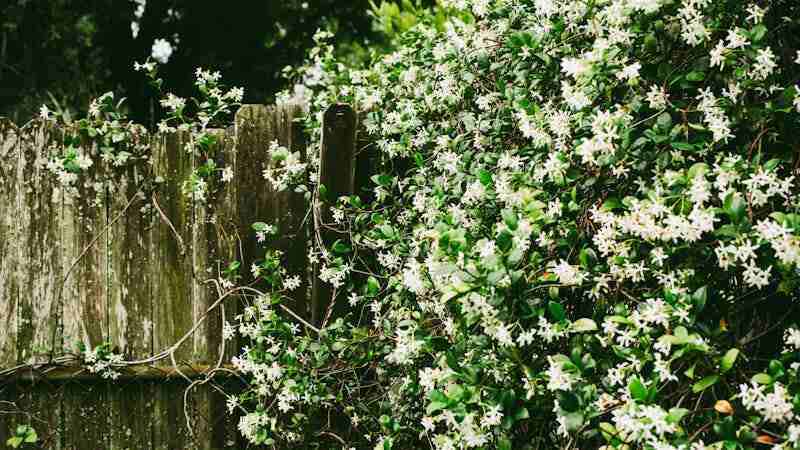
Confederate jasmine’s versatility makes it suitable for both indoor and outdoor cultivation, although each environment requires unique care. Indoors, ensure adequate sunlight and ventilation to avoid fungal problems. Outdoors, protect the plant from extreme temperatures and provide climbing support. Adjust water and humidity levels based on the plant’s location to keep the plant healthy
outdoor growing: Outdoors, Confederate jasmine makes a wonderful addition to garden beds, hedges, or trellises. Its rapid growth covers surfaces beautifully, and with the right support, it can climb 10-15 feet, providing a natural screen for privacy. Outdoor plants are more likely to bloom profusely because of their high exposure to sunlight.
Indoor growing
For indoor gardening, Confederate jasmine can be a wonderful plant to add greenery and fragrance to your home. However, it will require a bright, well-lit location, ideally near a south or east-facing window. Indoor plants may not grow as large or as flowery, but they still make a beautiful decorative vine. Indoor plants occasionally increase humidity, especially in winter when indoor air is dry.
Common problems and solutions
Even with ideal care, Confederate Jasmine can experience common problems that affect its health. Regular observation and prompt action can solve most problems before they escalate. Below are solutions to common problems like leaf yellowing and wilting, which are often caused by environmental stress:
Yellow leaves: Yellow leaves often indicate poor drainage or overwatering, which can lead to root rot. Adjust your watering schedule as needed, allowing the topsoil to dry out between waterings to promote root health. Consider improving soil drainage by adding organic matter, such as compost, to the planting area
Make sure the container or planting site has adequate drainage holes, as standing water can damage the roots over time. Check plant leaves and soil moisture regularly to catch early signs of overwatering and maintain optimal growing conditions
Wilting: Wilting can be caused by waterlogged soil, root rot, or insect infestation. Check the soil’s moisture level, make sure it’s not too wet, and inspect the plant for pests that could be causing stress. If root rot is present, improve drainage and remove any damaged roots to restore plant vigor
Slow growth or lack of flowers: If the plant is not blooming, it may need more sunlight or less fertilizer. Make sure it gets at least 4-6 hours of light daily and consider a phosphorus-rich fertilizer to encourage flowering. Ensure adequate light and balanced fertilizer for healthy flowers.
If your Confederate jasmine isn’t blooming as expected, it may indicate a need for more direct sunlight or an adjustment in fertilizer application. Additionally, avoid over-fertilizing, as excess nitrogen can promote plant growth at the expense of flowers. Instead, choose a phosphorus-rich fertilizer to promote bud formation and improve the plant’s overall flowering potential.
Tips for winter care
Confederate jasmine is semi-hardy, meaning it can withstand light frosts but may struggle in severe winter conditions. In cold weather, take proactive steps to ensure its health during the winter months.
Monitor temperatures closely, and be prepared to rescue the plant if frost threatens. With proper care, your jasmine can survive and thrive despite the challenges of winter
1. Mulching: Applying a 2-3 inch layer of mulch around the base of your jasmine acts as an insulating barrier, helping to protect the roots from temperature drops. Mulching keeps the soil warm and retains moisture, reducing plant stress during winter. Choose organic mulch materials such as straw, bark, or compost to nourish the soil as it breaks down
2. Frost protection: Cover plants or move them indoors to protect them from cold temperatures
When frost is forecast, give outdoor jasmine plants extra protection by covering them with breathable fabric.
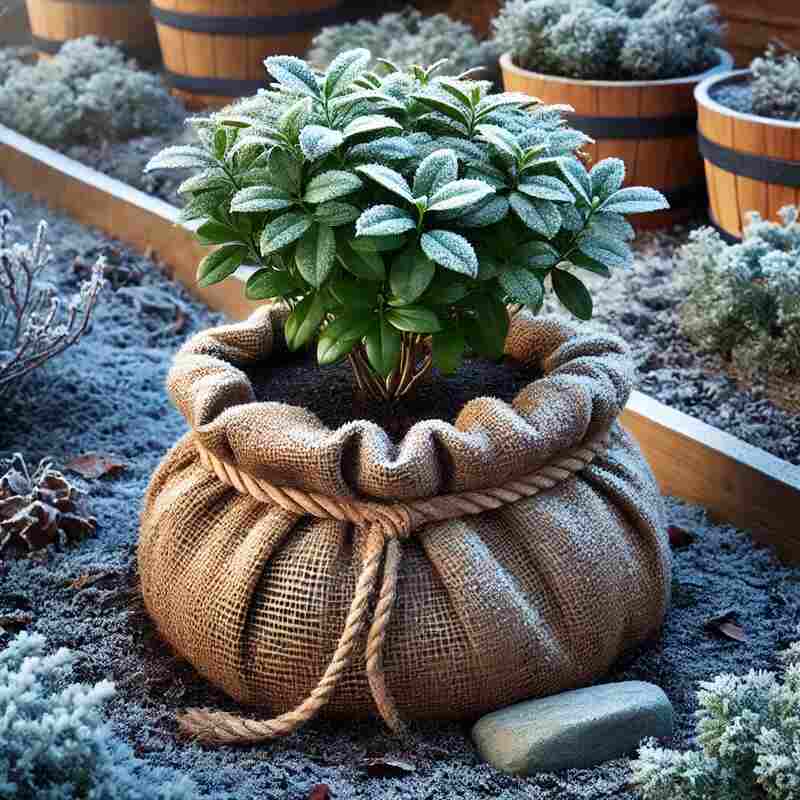
If your plant is in a container, consider moving it to a cool but sheltered location to avoid frost. These simple steps help ensure your plant stays healthy and ready to grow again when warmer weather returns.
Conclusion
Confederate jasmine is a beautiful, fragrant addition to any garden or home. With its lush green foliage and starry white flowers, it offers visual appeal and a welcoming fragrance. By understanding its growing conditions and following the care tips outlined above, even beginners can enjoy a healthy, thriving Confederate jasmine.
Remember to provide the right soil, sunlight, and regular maintenance, and this wonderful vine will reward you, With the right care, Confederate jasmine can quickly become a stunning focal point in your landscape, adding height and depth to fences, trellises, or walls.
Its hardy nature makes it a low-maintenance option, perfect for those who want a resilient yet strikingly beautiful plant. Whether you choose to plant it outdoors or in a container, Confederate jasmine’s fast growth and fragrant blooms create a refreshing ambiance in any setting.
As a bonus, it attracts pollinators like bees and butterflies, contributing to a healthy garden ecosystem.
With consistent care and attention, your Confederate jasmine will bring beauty and charm for years to come, making it a truly rewarding choice for any gardener.
